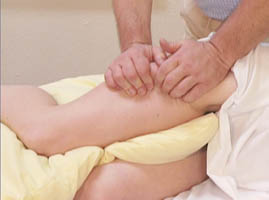Steps for Cellulite Reduction Massage
Cellulite is not considered by most to be pathology. However, cellulite makes many women very unhappy. As we know, an unhappy person cannot be healthy. Therefore, massage therapy for cellulite reduction will help people to be happier, and of course, healthier. Cellulite, appears like the skin of an orange peel and develops as a result of increased mass of subcutaneous fat and degenerative processes within the fibrotic cords which connect the dermis and superficial fascia. In this seminar, we will teach how to prepare (warm up) areas of cellulite for a great deal of massive mobilization of subcutaneous tissue which will help the skin to straighten out and lose the orange-peel appearance.
General Information About Cellulite
Cellulite is most commonly developed in the buttocks and lateral/posterior thighs. The anterior thigh doesn’t develop the “orange peel” or “cottage cheese” appearance as often as the posterior. This tendency is explained by the fact that the workplace has become more sedentary. Sitting at work all day additionally obstructs the blood supply to the buttocks/posterior thighs. This regular deprivation of blood supply eventually leads to acceleration of degenerative changes in the subcutaneous tissues; most notably, sclerotic changes in the fibrotic cords, expressed as the “orange peel” surface. Therefore, the goal of massage therapy for cellulite reduction is to reduce or eliminate the “cottage cheese” appearance by tearing or stretching the fibrotic cords.In an intensive effort to reduce cellulite, the best results will be achieved when the first 10 treatments are performed on a daily basis. Each treatment should focus on one or two localizations of cellulite. Approximately 10-15 minutes is the appropriate amount of time to spend treating each localization of cellulite. Therefore, each treatment will last about 15-20 minutes. Remember that the treatments, even when performed correctly (with care taken not to be aggressive), can cause slight bruising and discomfort in the days following the treatments. The therapist must attempt to limit and control the possible amount of discomfort the client may feel following the treatments.In any soft tissue mobilization massage for the extremities (whether upper or lower), one of the objectives of the treatment is to increase blood supply to the region. It has been clinically and scientifically proven that segment reflex massage is the most effective and efficient way to increase blood supply to the extremities. Therefore, begin the cellulite reduction treatment for the legs with segment reflex massage on the dorsal lumbo-sacral region.In order to understand the subsequent instruction in Cellulite Reduction Massage protocol you should be familiar with the 12 petrissage techniques used in Medical Massage.
The pictures offered below as steps illustration are the actual snapshots from the instuctional medical massage educational video #8Warm-up Massage Techniques – 7 mins.Perform approximately 7 minutes of warm-up massage; combination of effleurage, friction, petrissage #1 & #2 on the lumbo-sacral area.
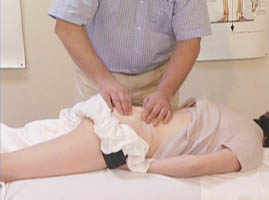 | 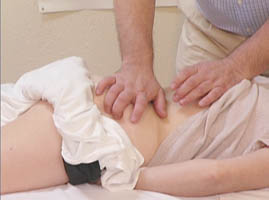 | 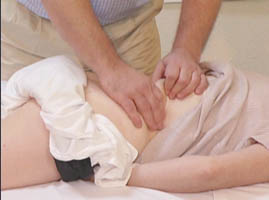 |
Cellulite Reduction Techniques for the thigh
Have client in laying position. Start with the posterior thigh (hamstrings).
Step 1
Warm up the hamstrings area with basic kneading techniques. (You can include the glutes, too)
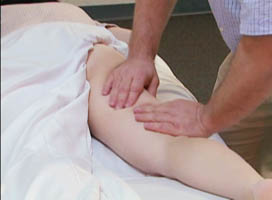
Step 2
Stretch the skin up with one hand, and use the back of the fingers of the other hand in a fast up and down motion to antagonize the stretched tissue for a few seconds on each location.
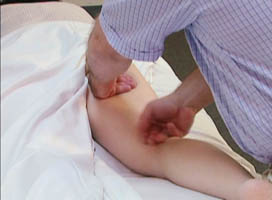
Step 3
Perform deep fascia release techniques on the hamstrings and glutes.
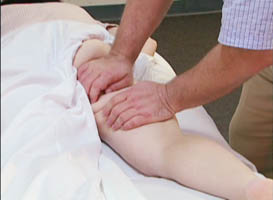
Step 4
Stand in front of the hamstrings. Grab a fold of skin between thumb and fingers and perform kneading, attempting to press the tips of the fingers deep to the fold of skin with each kneading motion.
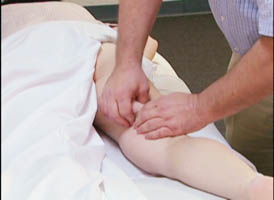
Step 5
Grab a fold of skin, use one hand to secure it in one place. Use the fingertips of the other hand to dig under the fold (to tear the fibrotic cords, break down calcifications and other mineral deposits, and ultimately stabilizing the metabolism/blood supply). Use this fold digging technique over the posterior thigh area.
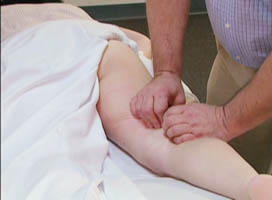
Step 6
Change position to stand next to the client’s leg (facing toward the client’s feet). Create horizontal folds and perform the same step as above
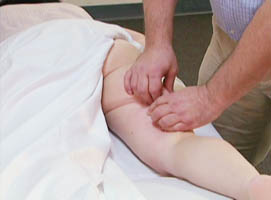
Step 7
Continue this one hand fold digging to the lateral thigh and up into the glutes area. Attention: In the area of the greater trochanter take care to use less pressure, and more pinching to avoid inflaming the greater trochanter bursa.
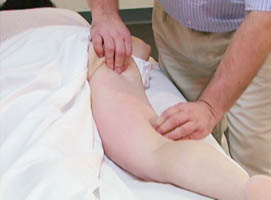
Step 8
Perform twisting deep fascia release. Place hands side by side, stretch the tissue opposite ways up and down as much as possible, apply a little pressure, then turn the hands (both the same direction) to twist the tissue as much as possible (without letting the fingers slide over the skin). Apply additional pressure, then quickly withdraw hands, allowing the tissue to spring back to normal. Note: This twisting fascia release technique will tear the fibrotic cords that have suffered the most shortening, most sclerotic changes. Another important benefit of this technique comes from the ischemic factor. All the pressure and twisting of the tissues interrupts the blood supply to the area (ischemia). The final compression amplifies this ischemic condition even more, and the quick release of this pressure/twisting opens a rush of arterial blood flow back into the area
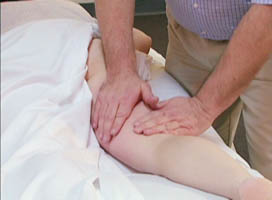
Step 9
With a closed fist, place the back of the fingers on the posterior thigh. Apply some pressure, then turn the hand and arm to twist the tissue. Compress the twisted tissue additionally, and release suddenly.
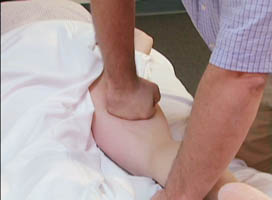
Lateral thigh
Have client lie on his/her side. Place a pillow between the client’s knees/lower legs.
Step 1
Stand facing the client’s back. Warm up the lateral thigh area with basic kneading techniques. They may be carried to the anterior part of the thigh, even slightly medial. (Please remember that the medial part of the thigh can be much more sensitive).

Step 2
Staying on the lateral side of the thigh, fold the skin between fingers and thumbs and stretch the fold medially (with thumbs) as much as possible. Under this maximum stretch, secure the fold with one hand. Use the fingertips of the other hand to dig under the fold (on the thumb side). As you move more medial, stretch the fold not just down, but pull it up, and dig under the finger side of the fold.
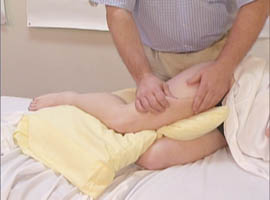
Step 3
Grab a fold of skin parallel to the thigh, twist it horizontally, and compress down under the fold.
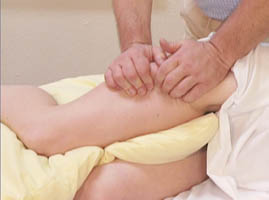
Step 4
Apply deep fascia twist with an additional grabbing compression. After the cellulite reduction treatment, it is highly recommended to perform classic massage (same techniques as the warm-up massage) on the treated area. As this treatment is actually tearing the fibrotic cords in the subcutaneous tissues, pain and bruising can occur the day after the treatment. The therapist must make an effort to prevent this as much as possible. Performing classic massage is critical to inhibit hemorrhaging in the tissues. Always remember to inform your client(s) of the possible side effects of the treatments.
